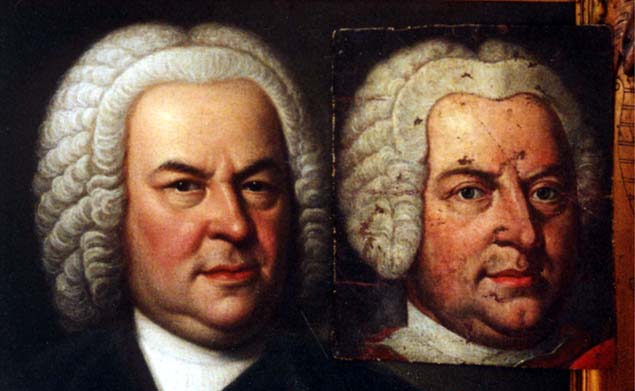The Critical Discographies from Choral Music On Records - Saint Matthew Passion Pages at the Teri Noel Towe
Home Pages
Johann Sebastian Bach
The Critical Discographies from Choral Music On Records
This remarkable photograph is not a computer generated composite; the original of the Weydenhammer
Portrait Fragment, all that remains of the portrait of Johann Sebastian Bach that belonged to his pupil
Johann Christian Kittel, is resting gently on the surface of the original of the 1748 Elias Gottlob Haussmann
Portrait of Johann Sebastian Bach.

1748 Elias Gottlob Haussmann Portrait, Courtesy of William H. Scheide, Princeton, New Jersey
Weydenhammer Portrait Fragment, ca. 1733, Artist Unknown, Courtesy of the Weydenhammer Descendants
Photograph by Teri Noel Towe
©Teri Noel Towe, 2001, All Rights Reserved
The Critical Discographies from Choral Music On Records
Saint Matthew Passion, BWV 244
Saint Matthew Passion, BWV 244
The Straube/Ramin Tradition
The Mendelssohn-Bartholdy tradition was also diluted by prominent musicians from Leipzig. The ever
growing revival of interest in authentic performance practice and in old instruments that had begun at the
turn of the century caused the influential organist and pedagogue, Karl Straube, who was Thomascantor
from 1916 to 1938, to be "born again" musicologically. He, who, in 1904, had published a performing
edition of Bach organ works for the symphonic late 19th century Romantic organ, made an about face in
the 1920s and espoused the cause of the return to a more authentic performance practice for Bach's
music. But, at heart, this close friend of Max Reger was still a late Romantic. The "new" Leipzig style that
he forged, and that he and his pupil Günther Ramin helped to popularize and disseminate, is, significantly,
less classical and straight-forward than the Mendelssohn-Bartholdy style, and is, in essence, a thorough
blending of the Mendelssohn tradition, Regeresque late Romanticism, and tenets of authentic performance
practice.
A comparison of either the Weißbach or the Mauersberger sets with the Ramin recording [20], for
instance, will make the differences apparent. Straube's successor as Thomascantor, Ramin may have used
smaller forces for his recording, made in the Thomaskirche in 1941, but his interpretation is much less
straight forward. It is granitic and rough hewn from the opening measures, and it is neither as urgent nor as
long phrased as the Weißbach or the Mauersberger. Ramin strives for and achieves a craggy
monumentality and consciously avoids sentimentality. Karl Erb is the top drawer Evangelist, and the
extraordinary Gerhard Hüsch sounds appropriately fresh and youthful as Jesus. Friedel Beckmann is the
solid, golden voiced contralto. As mentioned earlier, the score is severely abridged, as was the practice in
Thomaskirche performances in the early years of the 20th century. Ramin's son, Dieter, however, recalls
that his father battled hard with the recordings' producers to prevent still further abridgements. A complete
and uncut SMP with Ramin, dating from 1950, does, however exist, and it is to be hoped that it will soon
be released commercially.
For better or for worse, the Straube/Ramin approach to the performance of the Bach vocal music,
emphasizing as it did smaller ensembles, crisper articulation, and shorter phrases, seemed "closer" to
Bach's own practice, and it was quickly espoused by a significant number of younger conductors. The
most influential of these was Karl Richter, a student of Ramin's who emigrated to the West and established
the Munich Bach Choir, a crack ensemble of upwards of ninety voices. His 1958 recording of the SMP,
made for the authenticity minded Deutsche Grammophon Archiv Produktion label, had a tremendous
impact on performers and listeners alike. [47]
Somehow or other, Richter got the reputation of being the quintessential exponent of the modern German
"neo-Baroque" style. For that reason alone, what is most remarkable about Richter's approach to the
Saint Matthew Passion, and there are three commercial recordings and a television film version of it, is its
unabashed Romanticism. While his is essentially a more polished form of the granitic Ramin interpretation,
Richter proves to be more effusive than most conductors, and he has a decided preference for slow
tempos. The tempo of the opening chorus, for instance, is a little slower than Mengelberg's; and the
overall tactus is quite slow, too.
Of Richter's three commercial recordings, the first is indisputably the most convincing. The interpretation
is still fresh, and the soloists overall are the most satisfying. Haefliger makes his recording début as the
Evangelist, and it is immediately apparent that he was already one of the truly great interpreters of the rôle.
Fischer-Dieskau is also splendid in the bass arias. The second recording , which appeared only in Japan,
was issued as a memorial to the conductor and documents a concert performance given in Tokyo on May
29, 1969. [48] While both the chorus and orchestra seem tired at times, the opening chorus and many of
the other movements sound more chiseled and incisive. The tempos also seem even slower than on the
1958 recording. Another significant difference is the injection of a much more prominent organ continuo.
In fact, the continuo realizations in general have become more florid. Haefliger is once again the tenor
soloist, and the alto is the ever reliable Marga Höffgen.
The third and final recording , made shortly before Richter's sudden and premature death, is, sadly, no
credit to his memory. [49] While his spectacular interpretation of the B Minor Mass, BWV 232, stayed
ever fresh, familiarity with the Saint Matthew Passion bred stagnation. Richter's grand conception of this
score, which he clearly loved deeply, is marred by overinterpretation and fussiness. The opening chorus is
now not only slow but also disjointed. There is a curious slackness about the turgid overall tactus that
stands in sharp contrast to both his previous recordings and the relentless vigor of Klemperer's taut but
deliberate pacing. And now, for the first time, the pulse and tempo of the narrative are pushed and pulled
relentlessly. As disappointing as it is, Richter's valedictory recording of the Saint Matthew Passion has
many strong points. Peter Schreier is a laudable successor to Ernst Haefliger as the tenor soloist, and the
special clear, molten warmth of Janet Baker's voice brings a unique beauty to both "Buss und Reu" and
"Erbarme Dich, mein Gott". Richter, incidentally, accompanies the Evangelist at the harpsichord.
Often thought of as the inheritor of Richter's mantle as the most prominent choral conductor in Germany,
Helmuth Rilling, the founder of the Gächinger Kantorei of Stuttgart, is also very much an interpreter in the
Straube/Ramin tradition. His Saint Matthew Passion, however, has more of the Mendelssohn-Bartholdy
tradition in it than Richter's; it is brisker and more streamlined. [50] The pacing is dramatic, almost
operatic, but always tasteful. The solid group of soloists and impeccably trained chorus respond to
Rilling's interpretative demands easily and gracefully. The 1741 gamba versions of "Mein Jesus schweigt"
and "Geduld, Geduld" are used. Trivia buffs will be amused to note that David Thomas, now one of the
foremost early music singers in the world, sings the part of Judas Iscariot in Rilling's recording.
A decade earlier, in 1965, Karl Münchinger, another conductor based in Stuttgart, made one of the few
recordings of the Saint Matthew Passion in which a boys' choir is used. [51] Like Richter, although not
to the same degree, he opts for a slow overall pacing for his Raminesque account. All of the soloists are
of high quality, yet it has to be said that Peter Pears is not in as good voice as he had been for Otto
Klemperer a couple of years before. Elly Ameling is radiant and bright in the soprano solos, but it is the
indescribably beautiful singing of the tragically short-lived tenor Fritz Wunderlich that makes the
Münchinger set worth having. The 1741 forms of "Mein Jesus schweigt" and "Geduld, Geduld" are used.
Please click here to advance to Page 5 - Other Recordings, 1950 - 1989
Endnotes
Alphabetical Discography
Please click here to return to the Critical Discographies from Choral Music On Records Main Page.
P. S.: Please don't forget that, if you are interested in a thorough, accurate discography of the recordings
of the Saint Matthew Passion that have appeared since the preparation of this article, you should go at
once to Aryeh Oron's remarkable Bach Cantatas Website.
Please click on  to return to the Johann Sebastian Bach Index Page.
to return to the Johann Sebastian Bach Index Page.
Please click on the  to return to the Teri Noel Towe Welcome Page.
to return to the Teri Noel Towe Welcome Page.
teritowe@alumni.Princeton.EDU
Copyright, Teri Noel Towe, 1989, 1997, 2001
All Rights Reserved
The The Critical Discographies from Choral Music On Records - Saint Matthew Passion Pages
at the Teri Noel Towe Home Pages are PPP Free web pages.

The The Critical Discographies from Choral Music On Records - Saint Matthew Passion Pages
at the Teri Noel Towe Home Pages have received the HIP Woolly Mammoth Stamp of Approval from
The HIP-ocrisy Home Page.